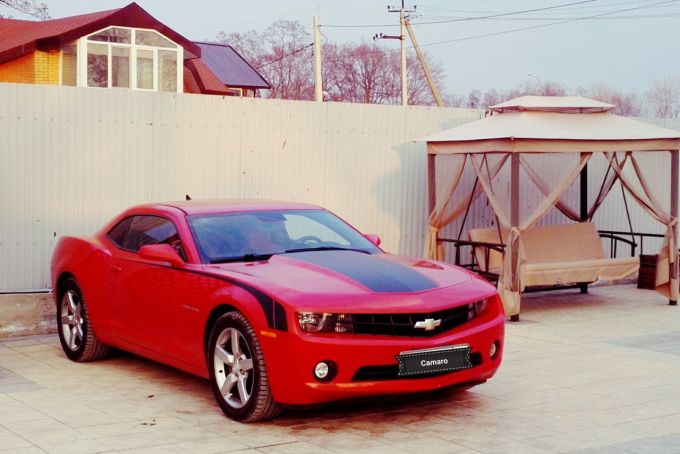
Chevrolet Camaro 2010 Overview
This car is a Commodore, but not as we know it. The Australian family hauler has been modified, teased and turned into something both retro and futuristic. This is a Camaro.
The great-looking two-door muscle car is the star of the Chevrolet showroom in the US, where sales are expected to top 80,000 vehicles a year, but Americans have no idea all the hard work on their hero has been done downstairs.
“The vision for the Camaro has always been simple. We had a lot of discussions about how to achieve this, but the vision was always clear,” says Brett Vivian, Director of Car Production for Holden and one of the key members of the team.
“It's all based on VE. It didn't need to be rebuilt, we just adjusted it,” says Gene Stefanyshyn, global line leader for rear-wheel drive and performance vehicles.
The Camaro was born as a result of General Motors' global program that made GM Holden the basis for large rear wheel drive vehicles. The idea was to build Australia's own Commodore and then use the mechanical platform and economical engineering expertise as the basis for other additional vehicles.
No one at Fishermans Bend will talk about the entire program, which many expected would result in the return of a compact car that could be called the Torana - but VE is well underway, there has been a successful Pontiac export program, and the Camaro.
To put it straight from the start, the Camaro is an amazing car. It looks right and drives right. There are medium muscle in the bodywork and the car is both quick and fast, yet surprisingly light and effortless to drive.
Hundreds of people worked on the Camaro program on both sides of the Pacific, from the design center in Fisherman's Bend to the Canadian plant in Ontario where the car is made. Road from Melbourne to Phillip Island.
That's where I came to take an exclusive ride in a pair of Camaro coupes as part of the World Car of the Year awards evaluation process. Holden rolled out a regular red V6 and a hot black SS, as well as top-notch test driver Rob Trubiani and a number of Camaro specialists.
They have a story that could easily fill a book, but the common ground is simple. The Camaro was born as part of a global rear wheel drive program, mechanically similar to the VE Commodore, but fully tied to the Camaro concept car that hit the 2006 Detroit Auto Show. convertible Camaro show car, but that's another story...
“We started this project at the beginning of 2005. May '05. By October, we fixed many proportions. They built a show car and in February '06 we started the project here in Australia,” says Stefanyshyn, before moving on to the heart of the car.
“We took the rear wheel and moved it about 150mm forward. We then took the front wheel and moved it forward 75mm. And we increased the wheel size from 679mm to 729mm. One of the reasons we moved the front wheel was to increase the size of the wheel. We also took the A-pillar and moved it back 67mm. And the Camaro has a shorter rear overhang than the Commodore.”
The Camaro concept was the cornerstone of the entire project, and one of the two cars was sent to Melbourne while the body was being prepared for production. “Every time we had a question, we just went back to the concept car,” says Peter Hughes, design manager. “We have the architecture from VE, and then we threw it off. The architecture is brilliant from below, proportionately it was on top. We also removed the roof by about 75 millimeters.”
The key to the car, according to Hughes, is the giant rear thighs. The huge side panel includes a sharp-radius guard that runs from the window line to the wheel. It took over 100 trial runs on a stamping press to get everything right and ready for production.
There are many, many more stories, but the end result is a car with a perfect 50:50 weight distribution, a choice of V6 and V8 engines, a cockpit with retro dials, and driving dynamics only surpassed in the US by the racing Chevrolet Corvette. Most importantly, the car looks perfect from every angle. This includes a wide channel through the center of the roof, a raised hood, semi-shrouded headlights, and the shape and placement of the taillights and tailpipe.
It's clearly inspired by the late 1960s Camaro muscle car, but with modern touches that keep the design modern. “On the road it looks pretty tough. He could sit a little lower, but this is a personal matter, ”says Hughes. The Camaro is so good that it was chosen for a role in the Hollywood blockbuster Transformers. Twice.
Driving
We already know that the VE Commodore drives well. And HSV Holdens, hyped from the base, rides better and faster. But the Camaro beats them all thanks to some key changes that greatly affect the response of the American oil car.
The Camaro has a large footprint and large tires, and a rear axle that is closer to the driver. The combination means better grip and better feel. With a smooth ride and handling course at the Lang Lang test site, the Camaro is significantly faster and, more importantly, easier to drive. He feels more relaxed, more tenacious and more responsive.
With top-notch GM Holden test driver Rob Trubiani at the wheel, it's just quick. In fact, it's frighteningly fast as it hits 140 km/h through a series of fast corners. But the Camaro also chuckles sideways in slow corners.
I did a lot of laps around the Lang Lang circuit and remember the slowest southpaw - copied from the Fisherman's Bend corner - where Peter Brock put his original HDT Commodores sideways to show what they can do. And high-speed turns where Peter Hanenberger once lost control and skidded back into the bushes - on the Falcon.
The Commodore handles the trail with ease, and the monster HSV gobbles up straight chunks and makes you keep your finger on the pulse as it rumbles through the corners. The Camaro is different. The SS V8 seems to be riding big balloons rather than Pirelli P-Zero tires. This is because a larger footprint with larger 19-inch wheels and tires provides better traction and a larger footprint. Look for the same package on a future Holden, though it will require significant suspension tuning - all done for the Camaro.
The Camaro is only the second American car I've driven with real steering feel, the other being the Corvette. It comes from the same retro garage as the revived Dodge Challenger and the latest Ford Mustang, but I just know that it drives a lot better than them.
The six-speed gear shift is pretty smooth, and 318 kilowatts from the 6.2-liter V8 is easy to power. In the cabin, I notice that the dashboard is pushed back further than the Commodore, and dials can only be Chevrolet. And a retro Camaro.
Inside, there is very little sign of Holden other than minor changes, which proves once again how much work went into making the Camaro right. Headroom is limited and visibility under the hood is a bit limited due to styling requirements, but that's all part of the Camaro experience. And it's a great experience. This is much more than I expected when I pulled into Lang Lang and good enough that I phoned the World COTY judges to encourage them to spend some time with the car.
The only question now is whether the Camaro will be able to return home to Australia. Everyone on the team is interested and left-hand drive cars hit the roads in Melbourne almost every day for appraisal work, but it all comes down to money and common sense. Unfortunately, this time the passion and quality of the Camaro is not enough.
